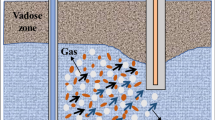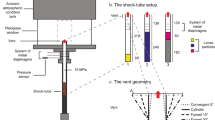Abstract
The fate of marine seep gases (transport to the atmosphere or dissolution, and either bacterial oxidation or diffusion to the atmosphere) is intimately connected with bubble and bubble-plume processes, which are strongly size-dependent. Based on measurements with a video bubble measurement system in the Coal Oil Point seep field in the Santa Barbara Channel, California, which recorded the bubble-emission size distribution (Φ) for a range of seep vents, three distinct plume types were identified, termed minor, major, and mixed. Minor plumes generally emitted bubbles with a lower emission flux, Q, and had narrow, peaked Φ that were well described by a Gaussian function. Major plumes showed broad Φ spanning very small to very large bubbles, and were well described by a power law function. Mixed plumes showed characteristics of both major and minor plume classes, i.e., they were described by a combination of Gaussian and power law functions, albeit poorly. To understand the underlying formation mechanism, laboratory bubble plumes were created from fixed capillary tubes, and by percolating air through sediment beds of four different grain sizes for a range of Q. Capillary tubes produced a Φ that was Gaussian for low Q. The peak radius of the Gaussian function describing Φ increased with capillary diameter. At high Q, they produced a broad distribution, which was primarily described by a power law. Sediment-bed bubble plumes were mixed plumes for low Q, and major plumes for high Q. For low-Q sediment-bed Φ, the peak radius decreased with increasing grain size. For high Q, sediment-bed Φ exhibited a decreased sensitivity to grain size, and Φ tended toward a power law, similar to that for major seep plumes.












Similar content being viewed by others
References
Allen AA, Schleuter RS, Mikolaj PG (1970) Natural oil seepage at Coal Oil Point, Santa Barbara, California. Science 170:974–977
Blanchard DC, Syzdek LD (1977) Production of air bubbles of a specified size. Chem Eng Sci 32:1109–1112
Boudreau BP, Algar C, Johnson BD, Croudace I, Reed A, Furukawa Y, Dorgan KM, Jumars PA, Grader AS, Gardiner BS (2005) Bubble growth and rise in soft sediments. Geology 33(6):517–520
Clark JF, Washburn L, Hornafius JS, Luyendyk BP (2000) Natural marine hydrocarbon seep source of dissolved methane to California coastal waters. J Geophys Res-Oceans 105:11509–511522
Clark JF, Washburn L, Schwager Emery K (2010) Variability of gas composition and flux intensity in natural marine hydrocarbon seeps. In: Bohrmann G, Jørgensen BB (eds) Proc 9th Int Conf Gas in Marine Sediments, 5–19 September 2008, Bremen. Geo-Mar Lett SI 30. doi:10.1007/s00367-009-0167-1
Clester SM, Hornafius JS, Scepan J, Estes JE (1996) Quantification of the relationship between natural gas seepage rates and surface oil volume in the Santa Barbara Channel, (abstract). EOS AGU Trans 77:F419
Fischer PJ (1978) Oil and tar seeps, Santa Barbara basin, California. In: Fischer PJ (ed) California offshore gas, oil, and tar seeps. California State Lands Commission, Sacramento, pp 1–62
Fischer PJ, Stevenson AJ (1973) Natural hydrocarbon seeps, Santa Barbara basin. In: Fischer PJ (ed) Santa Barbara channel area revisited field trip guidebook. American Association of Petroleum Geologists, Tulsa, pp 17–28
Hernandez-Aguilar JR, Cunningham R, Finch JA (2006) A test of the Tate equation to predict bubble size at an orifice in the presence of frother. Int J Min Process 79:89–97
Hornafius JS, Quigley DC, Luyendyk BP (1999) The world’s most spectacular marine hydrocarbons seeps (Coal Oil Point, Santa Barbara Channel, California): quantification of emissions. J Geophys Res-Oceans 104:20703–20711
IPCC (2001) Climate change 2001—the scientific basis. Cambridge University Press, Cambridge
Johnson BD, Cooke RC (1979) Bubble populations and spectra in coastal waters: a photographic approach. J Geophys Res 84(C7):3761–3766
Judd A, Hovland M (2007) Seabed fluid flow: the impact on geology, biology and the marine environment. Cambridge University Press, Cambridge
Khalil MAK, Rasmussen RA (1995) The changing composition of the Earth’s atmosphere. In: Singh HB (ed) Composition, chemistry, and climate of the atmosphere. Van Nostrand Reinhold, New York, pp 50–87
Kvenvolden KA, Rogers BW (2005) Gaia’s breath—global methane exhalations. Mar Petrol Geol 22:579–590
Kvenvolden KA, Lorenson TD, Reeburgh WS (2001) Attention turns to naturally occurring methane seepage. EOS AGU Trans 82:457
Leifer I (2010) Characteristics and scaling of bubble plumes from marine hydrocarbon seepage in the Coal Oil Point seep field. J Geophys Res. doi:10.1029/2009JC005844
Leifer I, Boles J (2005) Measurement of marine hydrocarbon seep flow through fractured rock and unconsolidated sediment. Mar Petrol Geol 22:551–568
Leifer I, Judd AG (2002) Oceanic methane layers: a bubble deposition mechanism from marine hydrocarbon seepage. Terra Nova 16:417–424
Leifer I, MacDonald IR (2003) Dynamics of the gas flux from shallow gas hydrate deposits: interaction between oily hydrate bubbles and the oceanic environment. Earth Planet Sci Lett 210:411–424
Leifer I, Patro RK (2002) The bubble mechanism for methane transport from the shallow sea bed to the surface: a review and sensitivity study. Cont Shelf Res 22:2409–2428
Leifer I, Tang DJ (2007) The acoustic signature of marine seep bubbles. J Acoustical Soc Am 121:EL35–EL40
Leifer I, Patro RK, Bowyer P (2000) A study on the temperature variation of rise velocity for large clean bubbles. J Atmos Oceanic Technol 17:1392–1402
Leifer I, de Leeuw G, Cohen LH (2003a) Optical measurement of bubbles: system design and application. J Atmos Oceanic Technol 20:1317–1332
Leifer I, de Leeuw G, Kunz GH, Cohen L (2003b) Calibrating optical bubble size by the displaced-mass method. Chem Eng Sci 58:5211–5216
Leifer I, Boles JR, Luyendyk BP, Clark JF (2004) Transient discharges from marine hydrocarbon seeps: spatial and temporal variability. Environ Geol 46:1038–1052
Leifer I, Luyendyk BP, Boles J, Clark JF (2006a) Natural marine seepage blowout: contribution to atmospheric methane. Global Biogeochem Cycles 20:GB3008. doi:10.1029/2005GB002668
Leifer I, Luyendyk B, Broderick K (2006b) Tracking an oil slick from multiple natural sources, Coal Oil Point, California. Mar Petrol Geol 23:621–630
Leifer I, Jeuthe H, Gjøsund SH, Johansen V (2009) Engineered and natural marine seep, bubble-driven buoyancy flows. J Phys Oceanogr 39:3071–3090
Leifer I, Kamerling M, Luyendyk BP, Wilson D (2010) Geologic control of natural marine seep hydrocarbon emissions, Coal Oil Point seep field, California. In: Bohrmann G, Jørgensen BB (eds) Proc 9th Int Conf Gas in Marine Sediments, 5–19 September 2008, Bremen. Geo-Mar Lett SI 30 (in press)
Leighton TG, Robb GBN (2008) Preliminary mapping of void fractions and sound speeds in gassy marine sediments from subbottom profiles. J Acoustical Soc Am 124:EL313–EL320
Mikolaj PG, Ampaya JP (1973) Tidal effects on the activity of natural submarine oil seeps. Mar Technol Soc J 7:25–28
Oguz HN, Prosperetti A (1993) Dynamics of bubble growth and detachment from a needle. J Fluid Mech 257:111–145
O’Hara SCM, Dando PR, Schuster U, Bennis A, Boyle JD, Chui FTW, Hatherell TVJ, Niven SJ, Taylor LJ (1995) Gas seep induced interstitial water circulation: observations and environmental implications. Cont Shelf Res 15:931–948
Patro R, Leifer I, Bowyer P (2002) Better bubble process modeling: improved bubble hydrodynamics parameterisation. In: Donelan M, Drennan W, Salzman ES, Wanninkhof R (eds) Gas transfer and water surfaces. American Geophysical Union, Washington, pp 315–320
Rehder G, Keir RS, Suess E, Rhein M (1999) Methane in the Northern Atlantic controlled by microbial oxidation and atmospheric history. Geophys Res Lett 26:587–590
Sauter EJ, Muyakshin SI, Charlou J-L, Schlüter M, Boetius A, Jerosch K, Damm E, Foucher J-P, Klages M (2006) Methane discharge from a deep-sea submarine mud volcano into the upper water column by gas hydrate-coated methane bubbles. Earth Planet Sci Lett 243:354–365
Sederman AJ, Gladden LF (2005) Transition to pulsing flow in trickle-bed reactors studied using MRI. AIChE J 51:615–621
Sills GC, Wheeler SJ (1992) The significance of gas for offshore operations. Cont Shelf Res 12:1239–1250
Slauenwhite DE, Johnson BD (1999) Bubble shattering: differences in bubble formation in fresh water and seawater. J Geophys Res 104:3265–3275
Tsuge H, Hibino S, Nojima U (1981) Volume of a bubble formed at a single submerged orifice in a flowing liquid. Int Chem Eng 21:630–636
Washburn L, Johnson C, Gotschalk CG, Egland ET (2001) A gas capture buoy for measuring bubbling gas flux in oceans and lakes. J Atmos Oceanic Technol 18:1411–1420
Washburn L, Clark JF, Kyriakidis P (2005) The spatial scales, distribution, and intensity of natural marine hydrocarbon seeps near Coal Oil Point, California. Mar Petrol Geol 22:569–578
Winkel ES, Ceccio SL, Dowling DR, Perlin M (2004) Bubble-size distributions produced by wall injection of air into flowing freshwater, saltwater and surfactant solutions. Exp Fluids 37:802–810
Acknowledgements
We would like to acknowledge the support of the NOAA NURP, the U.S. Mineral Management Service, Agency #1435-01-00-CA-31063, Task #18211, and the University of California Energy Institute. Special thanks to the University of California, Santa Barbara (UCSB) divers Shane Anderson, Dave Farrar, Dennis Divins, Christoph Pierre, and underwater videographer Eric Hessel, as well as Tonya del Sontro for help collecting submersible seep bubble video, and the crew of the Delta submersible. Thanks to Larry Vladic of Phantom Research for high-speed video of sediment bubble formation. Views and conclusions in this document are those of the authors, and should not be interpreted as necessarily representing the official policies, either expressed or implied, of the U.S. government or UCSB.
Open Access
This article is distributed under the terms of the Creative Commons Attribution Noncommercial License which permits any noncommercial use, distribution, and reproduction in any medium, provided the original author(s) and source are credited.
Author information
Authors and Affiliations
Corresponding author
Appendix
Appendix
- A (−):
-
Peak value of F in Gaussian functional fit
- C (−):
-
Circularity of bubble outline. Used in image processing
- DG (mm):
-
Equivalent spherical diameter of sediment grains
- F (# µm−1 m−1):
-
Function that represents either Φ or Ψ
- N (−):
-
Number of bubbles analyzed
- Q (L min−1):
-
Flow (corrected to STP)
- QLayer (L min−1):
-
Layer flux (total volume of bubbles in a layer)
- R2 (−):
-
Correlation coefficient
- RG (mm):
-
Equivalent spherical radius of sediment grains
- RP (µm):
-
Radius of peak concentration in Φ
- VB (cm s−1):
-
Bubble rise velocity in stagnant fluid
- VUP (cm s−1):
-
Upwelling velocity
- VV (cm3):
-
Porosity or sediment void volume
- VZ (cm s−1):
-
Bubble vertical velocity
- dBD (g cm−3):
-
Dry bulk density
- g (m s−1 s−1):
-
Gravity
- r (µm):
-
Equivalent spherical bubble radius
- rcap (µm):
-
Capillary tube orifice radius opening
- s (−):
-
Power law exponent in Φ
- t (s):
-
Time
- ϕ (cm3 cm−3):
-
Porosity
- ζ (−):
-
Relative density
- ρG (g cm−3):
-
Bubble gas density
- ρL (g cm−3):
-
Water density
- τ (µm):
-
Gaussian function half-width
- Φ (# µm−1 s−1):
-
Bubble flux size distribution
- Ψ (# µm−1 m−1):
-
Bubble-layer population size distribution
Rights and permissions
About this article
Cite this article
Leifer, I., Culling, D. Formation of seep bubble plumes in the Coal Oil Point seep field. Geo-Mar Lett 30, 339–353 (2010). https://doi.org/10.1007/s00367-010-0187-x
Received:
Accepted:
Published:
Issue Date:
DOI: https://doi.org/10.1007/s00367-010-0187-x




